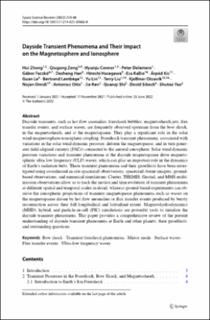Dayside Transient Phenomena and Their Impact on the Magnetosphere and Ionosphere
| dc.contributor.author | Zhang, Hui | |
| dc.contributor.author | Zong, Qiugang | |
| dc.contributor.author | Connor, Hyunju | |
| dc.contributor.author | Delamere, Peter | |
| dc.contributor.author | Facskó, Gábor | |
| dc.contributor.author | Han, Desheng | |
| dc.contributor.author | Hasegawa, Hiroshi | |
| dc.contributor.author | Kallio, Esa | |
| dc.contributor.author | Kis, Árpád | |
| dc.contributor.author | Le, Guan | |
| dc.contributor.author | Lembège, Bertrand | |
| dc.contributor.author | Lin, Yu | |
| dc.contributor.author | Liu, Terry | |
| dc.contributor.author | Oksavik, Kjellmar | |
| dc.contributor.author | Omidi, Nojan | |
| dc.contributor.author | Otto, Antonius | |
| dc.contributor.author | Ren, Jie | |
| dc.contributor.author | Shi, Quanqi | |
| dc.contributor.author | Sibeck, David | |
| dc.contributor.author | Yao, Shutao | |
| dc.date.accessioned | 2023-01-13T09:49:56Z | |
| dc.date.available | 2023-01-13T09:49:56Z | |
| dc.date.created | 2022-08-15T12:25:14Z | |
| dc.date.issued | 2022 | |
| dc.identifier.issn | 0038-6308 | |
| dc.identifier.uri | https://hdl.handle.net/11250/3043284 | |
| dc.description.abstract | Dayside transients, such as hot flow anomalies, foreshock bubbles, magnetosheath jets, flux transfer events, and surface waves, are frequently observed upstream from the bow shock, in the magnetosheath, and at the magnetopause. They play a significant role in the solar wind-magnetosphere-ionosphere coupling. Foreshock transient phenomena, associated with variations in the solar wind dynamic pressure, deform the magnetopause, and in turn generates field-aligned currents (FACs) connected to the auroral ionosphere. Solar wind dynamic pressure variations and transient phenomena at the dayside magnetopause drive magnetospheric ultra low frequency (ULF) waves, which can play an important role in the dynamics of Earth’s radiation belts. These transient phenomena and their geoeffects have been investigated using coordinated in-situ spacecraft observations, spacecraft-borne imagers, ground-based observations, and numerical simulations. Cluster, THEMIS, Geotail, and MMS multi-mission observations allow us to track the motion and time evolution of transient phenomena at different spatial and temporal scales in detail, whereas ground-based experiments can observe the ionospheric projections of transient magnetopause phenomena such as waves on the magnetopause driven by hot flow anomalies or flux transfer events produced by bursty reconnection across their full longitudinal and latitudinal extent. Magnetohydrodynamics (MHD), hybrid, and particle-in-cell (PIC) simulations are powerful tools to simulate the dayside transient phenomena. This paper provides a comprehensive review of the present understanding of dayside transient phenomena at Earth and other planets, their geoeffects, and outstanding questions. | en_US |
| dc.language.iso | eng | en_US |
| dc.publisher | Springer | en_US |
| dc.rights | Navngivelse 4.0 Internasjonal | * |
| dc.rights.uri | http://creativecommons.org/licenses/by/4.0/deed.no | * |
| dc.title | Dayside Transient Phenomena and Their Impact on the Magnetosphere and Ionosphere | en_US |
| dc.type | Journal article | en_US |
| dc.type | Peer reviewed | en_US |
| dc.description.version | publishedVersion | en_US |
| dc.rights.holder | Copyright The Author(s) 2022 | en_US |
| dc.source.articlenumber | 40 | en_US |
| cristin.ispublished | true | |
| cristin.fulltext | original | |
| cristin.qualitycode | 1 | |
| dc.identifier.doi | 10.1007/s11214-021-00865-0 | |
| dc.identifier.cristin | 2043000 | |
| dc.source.journal | Space Science Reviews | en_US |
| dc.relation.project | Norges forskningsråd: 223252 | en_US |
| dc.identifier.citation | Space Science Reviews. 2022, 218, 40. | en_US |
| dc.source.volume | 218 | en_US |

